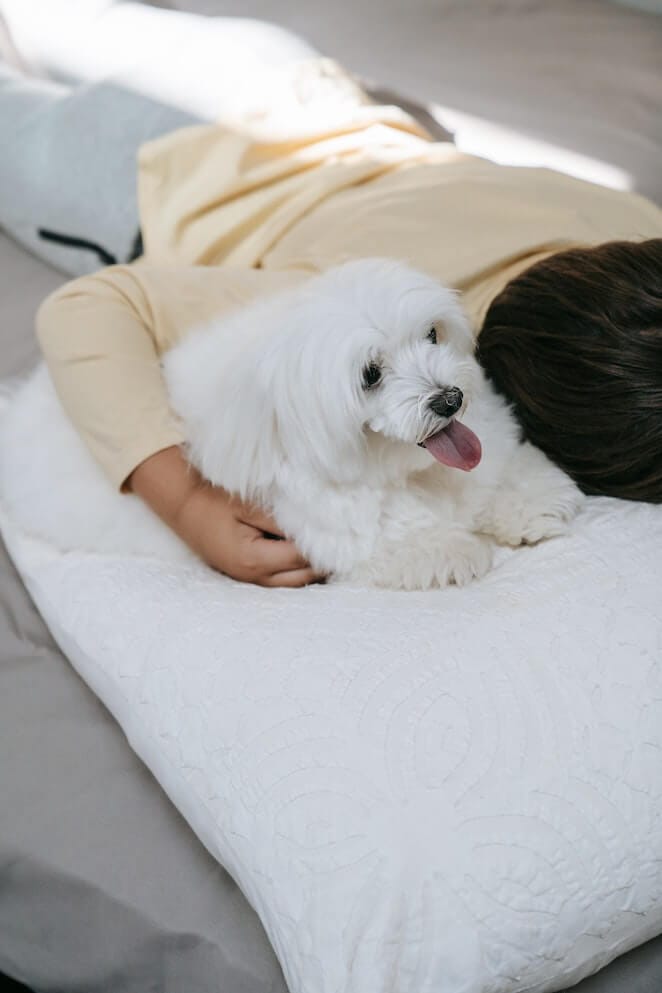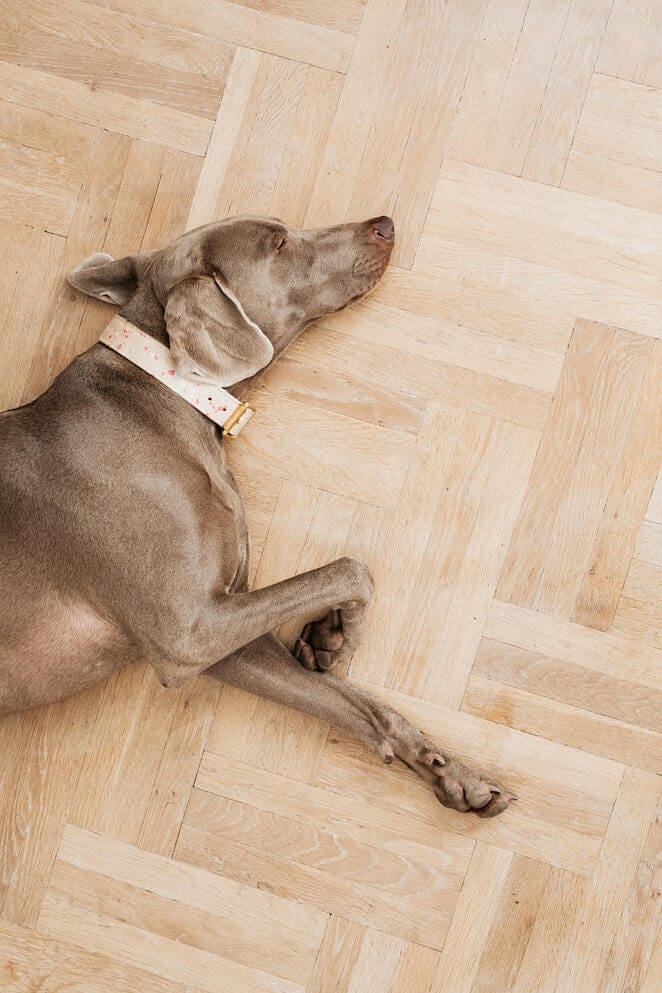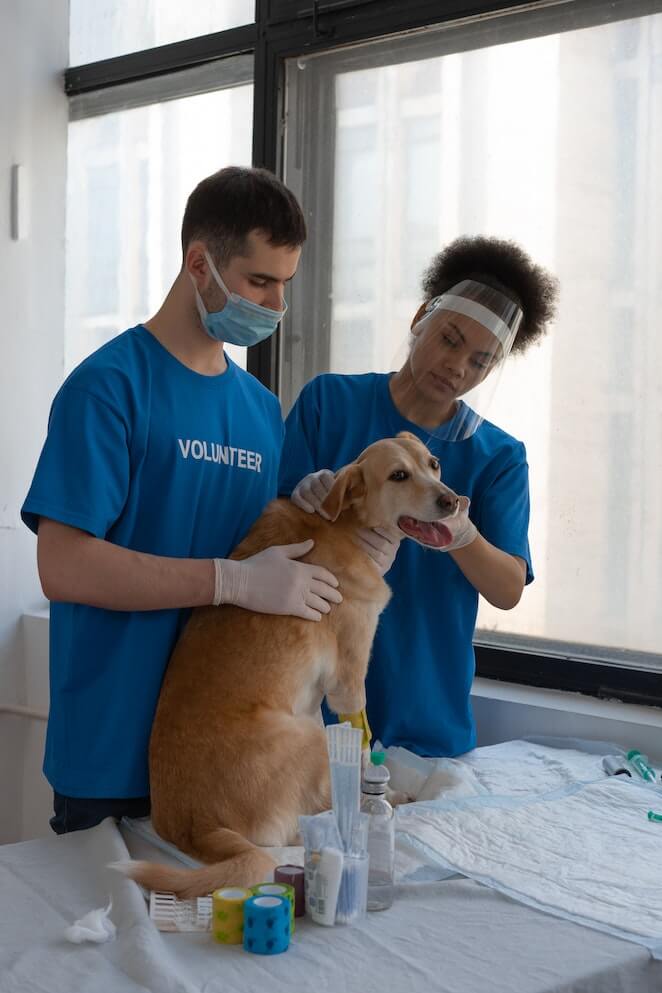
As a dog parent, you may have observed your dog twitching while they sleep. While this may be alarming at first, it is a normal phenomenon.
Twitching is a normal dog behavior in which the dogs are often completely relaxed and their muscles may twitch or jerk occasionally.
This is similar to the way humans sometimes move during REM sleep.
If you are wondering “why is my dog twitching” then this article is for you. Let’s understand the science behind it and the ways in which you can help your dog.
Why is my dog twitching in his sleep?

Dog twitching in sleep is a relatively common occurrence. There are a number of potential explanations for why your dog may be making these sudden movements while sleeping
1. Dreaming:
When humans dream, our bodies sometimes move involuntarily as our brain processes images and thoughts from the dream.
It’s likely that dogs experience something similar, and may twitch or move in their sleep as they dream about chasing a squirrel or playing with their favorite toy. Sometimes dogs get nightmares that might cause sudden jerks in the body.
Some dogs may twitch or paddle their legs while they are sleeping. This is usually due to the rapid eye movement (REM) stage of sleep when most dreaming occurs.
While some twitching during REM sleep is normal, if your dog seems overly restless then it should be evaluated by a veterinarian.
2. Sign of pain:
If a dog is lying in an awkward position, it may start to twitch or move in an attempt to get more comfortable. This is especially common if a dog is recovering from an injury or surgery.
3. Underlying health condition:
If a dog is twitching more than usual, or if the twitching is accompanied by other symptoms like seizures, it’s important to take them for a checkup.
Conditions like epilepsy can cause frequent and uncontrolled twitching, so it’s important to get a diagnosis and treatment plan from a professional.
Why is my dog twitching while awake?

There are a few reasons why your dog may be twitching while awake. It could be a sign of excitement or nerves, or it could be a medical condition.
- Excitement or nerves: Dogs may twitch when they’re excited or nervous. If your dog is panting and pacing around, chances are he’s feeling some strong emotion. When dogs get excited, they sometimes twitch as they try to contain their energy. Nervous dogs may also twitch as a way of releasing tension.
- Medical condition: Sometimes, twitching can be a sign of a medical condition. For example, if your dog is twitching and also has seizures, it could be a sign of epilepsy. Twitching can also be a symptom of other neurological disorders.
- Dietary issue: Another possible cause of twitching is a dietary issue. If your dog is not getting enough nutrients, he may start to twitch. This is especially true if your dog is not getting enough protein. A lack of vitamins and minerals can also cause twitching. If you think your dog’s diet may be the culprit, talk to your veterinarian about making some changes.
- Allergies: Allergies can also cause twitching. If your dog is allergic to something in his environment, he may start to twitch. This is especially true if the allergy is causing irritation or inflammation.
Should I be worried if my dog is twitching?

If your dog is twitching, it’s likely due to a muscle spasm. While muscle spasms can be uncomfortable, they do usually not cause concern.
If your dog is experiencing frequent or severe twitches, however, it’s important to have them examined to rule out any underlying health conditions.
There are a few things you can do to help. First, try to identify what is causing the twitching. If it is due to anxiety or excitement, try to calm your dog down with soothing words and petting.
If the twitching is due to a medical condition, such as seizure disorder, contact your veterinarian for advice on how to best help your dog.
In general, however, there are a few things you can do to help any twitching dog:
- Provide a calm environment: Dogs who are anxious or excited are more likely to twitch. Try to create a calm atmosphere for your dog, using soft voices and gentle petting. Dogs love kisses so you can hug and kiss them to calm them down.
- Reduce stimuli: If your dog is twitching due to a medical condition, reducing stimuli can help lessen the severity of the twitching. Turn off the television, close the blinds, and reduce other sources of noise and light.
- Give your dog a massage: Gently massaging your dog’s muscles can help relax them and reduce twitching.
- Apply pressure: Applying pressure to the affected area can help stop or reduce muscle spasms.
- Offer reassurance: Dogs who are anxious or nervous may benefit from reassurance from their owners. Try speaking in a calm, soothing voice and offering petting and scratches.
Is my dog twitching or having a seizure?

Twitching and seizures are two separate conditions.
Twitching usually refers to small muscle movements that can be caused by a variety of things, such as stress or excitement.
Seizures, on the other hand, are larger muscle movements that are often associated with a medical condition. Here are some ways to tell the difference between twitching and seizure:
- Twitching is usually more localized and only affects a small area of the body. Seizures, on the other hand, often affect larger areas of the body and can even cause convulsions.
- Twitching is often caused by things like stress or excitement, while seizures are often indicative of a medical condition.
- Twitching generally lasts for a shorter period of time than seizures. Seizures can last for several minutes or even hours.
A vet will be able to properly diagnose the problem and recommend the treatment.
Final Words

If you notice your dog twitching, it’s important to pay attention to other signs and symptoms.
If the twitching is accompanied by other neurological symptoms, such as seizures, weakness, or paralysis, it could be a sign of a serious condition.
However, if your dog is otherwise healthy and the twitching is not accompanied by any other symptoms, it’s likely harmless and nothing to worry about.
In any case, if you’re concerned about your dog’s health, it’s always best to consult with your veterinarian.


GIPHY App Key not set. Please check settings